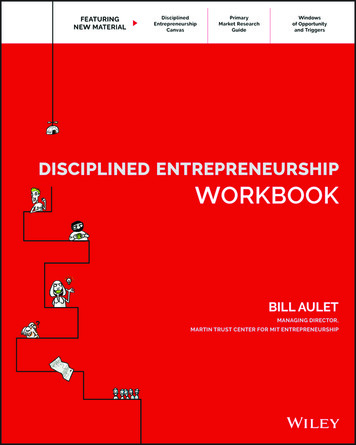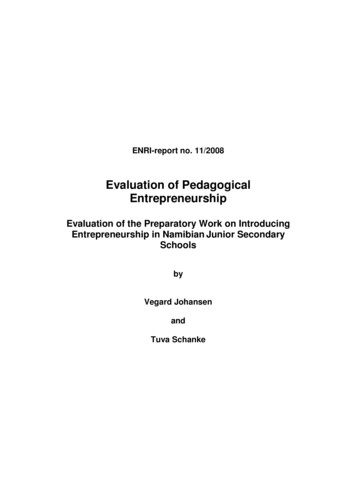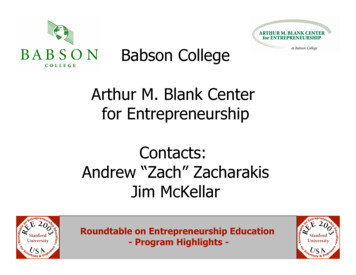
Transcription
ENTREPRENEURSHIP CURRICULUMPROJECT REPORT FOR JIP GRANTJEFF KEEPRATHIMA RODRIGUESSUDARSANA KUNDUJEAN LOUIS RACINE1
ACKNOWLEDGMENTSThe authors would like to thank the Tokyo Foundation Japan for awarding usthe Sasakawa Young Leaders Fellowship and the JIP Grant. This project wouldnever have been possible without their generosity and encouragement.We would also like to thank all the individuals and organizations that helped usdevelop this Curriculum and friends and family who supported us along theway.2
TABLE OF CONTENTSABSTRACT .4RATIONALE FOR THE PROJECT .5ENTREPRENEURSHIP AND ECONOMIC GROWTH.6ENTREPRENEURSHIP EDUCATION AND ECONOMIC G ROWTH .9THE PROJECT: ENTREPRENEURSHIP CURRICULUM .12IDENTIFICATION OF TARGET GROUP .12ENTREPRENEURSHIP EDUCATION: A SURVEY OF DIFFERENT COUNTRIES .13ENTREPRENEURSHIP EDUCATION: SURVEY OF ORGANIZATIONS .15UNITED STATES .16INDIA.18DEFINITION OF ENTREPRENEURSHIP/IDENTIFICATION OF ENTREPRENEURIAL TRAITS .20MEASURING ENTREPRENEURSHIP .23PEDAGOGY .26FINAL OUTPUT .29IMPLEMENTING PARTNER .31LIMITATIONS AND RECOMMENDATIONS.33ANNEXURE I .34ANNEXURE II .35BIBLIOGRAPHY.363
ABSTRACTThis project has been an action–research project with an ultimate aim of preparinginstructional material for educators in developing countries to foster entrepreneurship amonghigh school children.The project was conducted in two phases. In the first phase an extensive research wasconducted to understand the link between entrepreneurship and economic growth and the roleof entrepreneurship education, identification of entrepreneurial traits, examination of differentpedagogy. Research was done through an exhaustive survey of existing literature and throughspeaking to different educators and organizations in the field of education, especiallyentrepreneurship education.In the second phase, the project team identified an implementing partner (Institute ofPsychological and Educational Research, India) and developed an entrepreneurship educationcurriculum for the partner. The curriculum, therefore, is primarily designed for high schoolstudents (ages 15-18) in India. However, it can be modified to suit the peripheral age rangeand used for disseminating to students in any developing country. The curriculum teachesstudents skills to run a business and, fosters opportunity recognition, innovation, risk-takingand critical thinking among the students.The curriculum has been designed in the form of a workshop but can be adapted to form aregular semester length course. The pedagogical tools used are essentially interactive andexperiential breaking away from the traditional teaching methods that are prevalent in mostdeveloping countries. The curriculum is being delivered in the form of a toolkit and has twocomponents: (i) a teacher guide and (ii) a student work book.4
RATIONALE FOR THE PROJECTMore than one billion people today are between 15 and 25 years of age and nearly 40 per centof the world's population is below the age of 20 (ILO, 2007). Eighty-five per cent of theseyoung people live in developing countries where many are especially vulnerable to extremepoverty (ILO, 2007). The International Labor Office estimates that around 88.2 million youngwomen and men are unemployed throughout the world, accounting for 47 per cent of all the185.9 million unemployed persons globally, and many more young people are working longhours for low pay, struggling to eke out a living in the informal economy. The challengefacing the world today is to make education meaningful and more inclusive to this set ofyoung people around the globe (UNICEF 2000, UNESCO 1996, 2000, 2004 and 2005)Education is widely recognized as one of the most critical means of defeating the challengesof development, poverty, and inequality. However, the current quality of education indeveloping economies (especially in South Asia) leaves much to be desired. The focus is onrote learning and the education system does not actively encourage students to think on theirown and take on responsibilities. It neglects the importance of developing a creative mindsetamong children, which means that the significance of education as a tool for personaldevelopment is severely hampered by such a form of education (UNESCO 1996, 2004).This was the basis and the genesis for our project. The project team wanted to devise acurriculum, which would address some of the existing deficiencies of the education system,bridging a gap between the needs of the economy of countries and the needs of individualstudents and identified entrepreneurship and as a key need for economic development andtherefore focused our attention on entrepreneurship education. This premise is corroboratedby the literature survey that follows.5
Entrepreneurship and Economic GrowthAs long back as in the 18th century Jean-Baptiste Say, a French textile manufacturer andeconomist, wrote that the human contribution to economic growth came in three types:scientists, workers, and entrepreneurs (Scott 1933).However, the rise of a definitiveeconomic theory correlating entrepreneurship and economic growth can be traced back to theearly works of Schumpeter. Schumpeter saw the entrepreneur playing a key role in theeconomic world. The Schumpeterian entrepreneur seeks to create new profit opportunitiesthrough his innovative activities or ‘creative destruction’ (Schumpeter 1934). Improvedproducts and more efficient processes of production were developed by the entrepreneur,thereby funneling funnels economic growth and producing a stronger, more efficienteconomy. Similarly it has been propounded by other economists that the entrepreneur as aninnovator and inspirer, the implementer of creative destruction, creating instability,disequilibria, and economic development (Baumol, 1968). The role of entrepreneurship in theeconomic development process is also explained through the role played by entrepreneurs inthe presence of market imperfections (Leibenstein, 1968). Leibenstein notes that in thepresence of market imperfections, entrepreneurs are needed to "search, discover, and evaluateopportunities, marshal the financial resources necessary for the enterprise, make time-bindingarrangements, take ultimate responsibility for management, and be the ultimate uncertaintyand/or risk bearer." This notion is extended by the concept that the entrepreneur identifiesand profits from a situation of disequilibrium by improving on market inefficiencies ordeficiencies (Kirzner 1973). Furthermore, it is argued that new opportunities themselvesemanate from the insights of entrepreneurs (Holcombe 1998). Entrepreneurship, therefore,creates changes, and changes produce more opportunities for entrepreneurship. Holcombe6
asserts that, “the engine of economic growth is entrepreneurship.” A subsequent study (North1990) also declares an explicit link between economic growth and the entrepreneur. Northclaims, “The agent of change is the individual entrepreneur responding to the incentivesembodied in the institutional framework.” The role of entrepreneurs in economic growth isfurther endorsed by a subsequent study (Eliasson and Braunerhjelm 1998), which suggeststhat economic growth stems from human embodied tacit competencies. The critical role ofentrepreneurship from a national perspective is also encapsulated in the idea of comparativeadvantage (Porter, 1990). Porter avers, “Invention and entrepreneurship are at the heart ofnational advantage. [.].” The link between entrepreneurship and economic growth is alsodemonstrated by the contribution of small firms in modern economies (Acs 1996). Acs claimsthat small firms play an important role in the economy, as they are agents of change throughtheir entrepreneurial activity and source of considerable innovative activity, therebystimulating industry growth and creating new jobs. Audretsch also states, “Entrepreneurshiphas become the engine of economic and social development throughout the world”(Audretsch 2003, p. 5).There have been other attempts in recent years to include entrepreneurship in growth models,(Segerstrom, Anant and Dinopoulos 1990, Aghion and Howitt 1992, Helpman 1992,Acemoglu 1995, Henrekson 2002, Aghion and Zilibotti 2003. The knowledge spillover theoryof entrepreneurship suggests that entrepreneurship provides a crucial mechanism in theprocess of economic growth by serving as a conduit for knowledge spillovers (Audretsch,Keilbach, Lehmann 2006). There seems to be a universal consensus on the notion thatentrepreneurship to play a decisive role in the virtuous cycle that promotes economic growth(Salgado-Banda 2005).7
There is also significant empirical evidence that there is a linkage between entrepreneurshipand economic growth. Historically, the industrial revolution owes a lot to the entrepreneurs ofthis era. Similarly, there is substantial proof of the role of entrepreneurship in Europeanhistory (Wennekers et al 1997). More recently the growth of the Chinese economy has beensignificantly contributed by entrepreneurs and the emergence of small firms. “All sorts ofsmall enterprises boomed in the countryside, as if a strange army appeared suddenly fromnowhere," remarked Deng Xiaoping, reflecting in 1987 on the first eight years of China’seconomic reforms (Zhao, 1996, p. 106). These startup firms strengthened the budding marketeconomy by creating jobs, supplying consumer goods, mobilizing savings and ending thestate firms’ monopoly. The Global Entrepreneurship Monitor (2000 and 2004) concludes thatthere is a strong relationship between entrepreneurial activities, defined as start-up activities,and economic growth. In the study, this definition of entrepreneurship is claimed to constitutethe singularly most important factor for economic growth. Similarly a study of computers andprocess control instruments firms in the US indicate the role of new entrepreneurial firms inthe innovation process (Acs and Audretsch 2001). There is also data, which demonstrates thatincreases in the birth rate of firms leads, after some lag, to higher levels of productivity(Holtz-Eakin and Kao 2003). Similarly other empirical studies have demonstrated thatVenture Entrepreneurship is positively related to GDP growth rate (Tang and Koveos, 2004).It has also been suggested that India’s current growth can largely be attributed to the efforts ofentrepreneurs coming out of a government-controlled environment to a market basedenvironment (Lal, Anil-K; Clement, Ronald-W, 2005). Based on empirical studies conducted,the Commission of the European Committees (February, 2006) states: “If Europe wants tosuccessfully maintain its social model, it needs more economic growth, more new firms, moreentrepreneurs willing to embark in innovative ventures, and more high-growth SMEs".8
Entrepreneurship Education and Economic GrowthThe education system plays a critical role in the economic advancement of nations since it isthe primary developer of human resource. Almost all endogenously growth theory modelrecognizes that the quality of human resources and thereby the quality of education is vital tothe economic growth process.However, the current quality of education globally, and especially in developing economies,leaves much to be desired. The focus is on rote learning and the education system does notactively encourage students to think on their own and take on responsibilities. The result isthat the significance of education as a tool for personal development is severely hampered bysuch a form of education. Moreover, in most developing economies, there are issues of largescale dropouts among school children, especially at the secondary level, since they do not seeany value attached to their education in securing employment. Even if they drop out with aview to find work, these students are ill equipped to compete for jobs in the urban market. Theresult is the creation of a large unproductive labor force or what economists call surplus labor.If children were encouraged to stay in school through incentives in education itselfsupplemented with financial and other incentives, parents and children would be more willingto bear the opportunity cost of enrolment.Entrepreneurship education is able to address some of the deficiencies in the existingeducation system. Firstly, the development of entrepreneurial skills in the education systemincreases the supply of future entrepreneurs in the country. A venture support system based onentrepreneurship education designed to stimulate and facilitate entrepreneurial activities,could result in a lower unemployment rate (McMullan & Long, 1987), increasedestablishment of new companies, and fewer failures of existing businesses (Hatten &9
Ruhland, 1995; Ronstadt, 1985; & Hansemark, 1998). Moreover, given the unemploymentproblems in most developing countries as well as rising unemployment levels in developedcountries in the face of globalization, the development of entrepreneurial skills as well asknowledge and skills in venture creation process prepare students for the realities of life whenthey graduate. The application of entrepreneurial competencies in daily life empowersstudents to learn business and enhance their social and life skills. In so doing fosters valuesand skills that are so dearly needed by today’s society.This view is endorsed by several educators who believe that entrepreneurship education playsa vital role in the economic progress of states. There is also empirical evidence related toentrepreneurial education as an intervention tool for impacting adult attitudes towardentrepreneurship (Ede, Panigrahi, & Calcich, 1998; Hansemark, 1998; Hatten & Ruhland,1995) and on youth awareness and attitudes about the social and economic desirability ofentrepreneurship as a career option (Kourilsky & Walstad, 1998; Walstad & Kourilsky, 1999).Economic commissions and other government advisory organizations are also warming up tothe notion that entrepreneurship education plays an important role in economic growth. In theyear 2000 the UN Youth Employment Network (YEN) was established under the proposal ofthe UN Secretary-General, which comprises the UN, the ILO World bank and well-knownspecialists on youth issues, and provides advice and support for the generation of youthemployment opportunity and solution of youth unemployment. The YEN also takesentrepreneurship as one of the four solutions to employment problem. (The four solutions inshort refer to four Es, namely: Employability, Equal Opportunities, Entrepreneurship andEmployment Creation) (UN 2006).Similarly, an educational monograph published by the Organization for EconomicCooperation and Development (OECD) entitled “Towards an Enterprising Culture” stated10
that, “Changes in educational method are needed . to foster competence in being‘enterprising’ as a vitally important qualification needed by the young as they enter society.This competence means having the ability to be creative and flexible, to be able to take andexercise initiative and to be able to solve problems.”In a growing economy like India, there are several proponents of entrepreneurship education.It has been suggested that to enhance India’s already rapid economic growth rate, India mustnow provide opportunities for (1) education directed specifically at entrepreneurial skills, (2)financing of entrepreneurial efforts, and (3) networking among potential entrepreneurs andtheir experienced counterparts (Lal,-Anil-K; Clement,-Ronald-W, 2005).11
THE PROJECT: ENTREPRENEURSHIP CURRICULUMBased on the research conducted, as elaborated above, the project team was able to identifythat entrepreneurship education was indeed a felt need and is critical for economicdevelopment. The aim of the project group was therefore to devise a curriculum fordeveloping economies. In so doing it faced four critical challenges: (i) identification of thetarget group, (ii) defining and measuring entrepreneurship or identifying entrepreneurial traits,(iii) deciding on a particular pedagogy and (iv) content of the curriculum. In order to identifythe content and the pedagogy it was critical for us to understand the best practices in the fieldof entrepreneurship education. We therefore researched the state of entrepreneurshipeducation in different parts of the world, and contacted several organizations, which areleading experts in providing entrepreneurship education or have broken away from thetraditional mode of teaching. We contacted organizations both in the developed world (US)and the developing (India) to get a balanced perspective for the content and pedagogy for ourcurriculum. We have elaborated the steps we followed to design our curriculum hereafter.Identification of target groupIt was crucial for the research team to identify the ideal age group that this curriculum shouldtarget. A preliminary research of data reveals that secondary school (ages 11-17) pupils aremost likely to drop out of school. Most developing countries have some system of provisionof free primary school education, at least in terms of school fees. However this does notextend into secondary schools and parents soon take out their children out of school. Thisindicated that secondary school students would be an ideal age group for the project team to12
target.It is believed that the ideal stage to acquire basic knowledge about entrepreneurship and tofoster a positive attitude towards entrepreneurship is during childhood and adolescence years(Filion 1994; Gasse 1985). Gasse in fact recommends that entrepreneurial potential should beidentified and evaluated at the secondary school level, during the developmental stage whenthe possibility of self-employment as a career option is still open. However, studies revealthat university-based entrepreneurship curricula has attracted the bulk of research within thearea of entrepreneurship education (Gorman, Hanlon et al. 1997; Young 1997, Vesper 1990)leaving a gap in the literature pertaining to pre-university entrepreneurship and enterpriseprograms. However, entrepreneurship development in primary and secondary schools isreceiving growing attention (Donckels 1991; Gasse 1985; Kourilsky 1995) because studentsin these age groups have expressed a desire to participate in entrepreneurship educationprograms.Based on student enrollment data and drop out rates and research as enumerated above it wasdecided to target students in high school in the age group of 15-18 in developing countries.Entrepreneurship Education: A Survey of Different CountriesWe surveyed the status of entrepreneurship education in different countries. Our studyindicates that entrepreneurship education exists mostly in the secondary vocational medium orat the graduate level through business management courses. Although in many developedcountries, the existing curricula encourage students to take initiative and responsibility,examples of more explicit entrepreneurship education are few. The main players in the fieldof entrepreneurship education are non-profit organizations assisted by the private sector.13
Coherent initiatives or educational programs on entrepreneurship by state authorities are stillrare in the field of school education.In Poland, “Basics of Enterprise” is a compulsory subject in secondary vocational schools.Objectives include developing entrepreneurial attitudes and learning to start a business. InAustria, entrepreneurship is part of the curriculum of secondary level technical vocationaleducation, for example in the form of students running a fictitious firm. Ireland runs programslike the Transition Year and the Leaving Certificate Vocational Program, which providestudents with an opportunity to experience entrepreneurship. The German VocationalTraining System offers some real life learning by placing students both in the school and thefirm and offering them an opportunity to set up their own companies in the final phase of theirtraining. The government of Netherlands provides support in the form of development ofteaching materials and training to teacher for pilot projects on entrepreneurship education insecondary schools. In Norway, Young Enterprise Norway is a partner for the Government inimplementing the Strategy for Entrepreneurship Education. In 2004, 14 percent of all studentsleaving upper secondary school had participated in the Student Company Program. The pastdecade has witnessed an explosion in the number of entrepreneurship education programs inthe USA. There are several well known actors including the National Foundation forTeaching Entrepreneurship (NFTE) which has both a nation wide presence as well ascollaborations with other organization in several other countries. Furthermore the Consortiumfor Entrepreneurship Education (CEE), which was founded in 1982 in response to a PolicyPaper from the US department of Education, has developed content standards forentrepreneurship education in schools. But even in the US there is a wide gap betweendemand and supply. In a testimony to the house of representatives, representative of CEE(June 07, 2006) reveal that in a poll by Gallup organization, conducted in conjunction with the14
Kauffman Foundation found that 70 percent of students polled at the high school level wantedto start their own business and yet only 44 percent had any basic knowledge regardingentrepreneurship.Data from developing countries on the entrepreneurship education is patchy. A study onKenya, Botswana, Uganda (World Bank 2002) reveals that entrepreneurship education isessentially provided through technical and vocational training (TVET) and the pedagogyessentially remains limited to traditional classroom teaching even though the learningoutcome is to teach students on how to start and run a business. The data for most of otherdeveloping nations is very similar. Entrepreneurship education is either limited to universitylevel education or to vocational training institutes.Entrepreneurship Education: Survey of OrganizationsIn an attempt to understand the pedagogy used in entrepreneurship education in developed aswell as developing countries, we surveyed some of the organizations impartingentrepreneurship education in the USA and India. These organizations have produced someof the best practices in the field and are widely acclaimed in the field of entrepreneurshipeducation. Inputs from these organizations were taken through face-to-face interviews, phoneinterviews and through e-mail communication. Their inputs have formed a critical part of ourassessment of what works in entrepreneurship education and what does not. You will findbelow a summary of the focus of their work and target groups and pedagogy. Annex B liststhe addresses and contact persons of each of these organizations. We hope this will be of useto others working or aiming to work in the field of entrepreneurship education.15
UNITED STATESMaking Cents InternationalMaking Cents International is a consulting firm committed to job creation and improved livelihoodsand opportunities through training and services for entrepreneurs, in the USA and worldwide. Theorganization specializes in providing innovative education materials and training for organizationsoffering youth entrepreneurship or adult micro and small enterprise training. Making Cents'Entrepreneurship and Business Management curricula are extremely effective tools for creating,strengthening and supporting current and future entrepreneurs. The effectiveness is rooted in theexperiential-learning methodologies that the curricula use. Through simulations, structureddiscussions, participatory exercises and peer-learning techniques, experiential-learning methodologybrings real-life experience and opportunity into the training room and creates learning that is relevant,immediately applicable and long-lasting. Curricula include practical application such as writing abusiness plan and setting-up and running a mini-business during the training course.Empowerment GroupThe Empowerment Group is a non-profit organization located in Kensington, North Philadelphia.Their mission is to accelerate economic growth in distressed urban communities by cultivating localentrepreneurship to create positive, lasting change for our clients, their families and their communities.They offer entrepreneurship training and resources for entrepreneurs of all ages and backgrounds.The Empowerment Group runs The Youth Entrepreneurship Program (YEP) is a hands-on programrun at after-school and summer programs throughout Philadelphia. These classes introduce youth toentrepreneurship and business planning by having them plan and implement their own business ideas,right there at their own after-school or summer program! Instructors create a business environment byhaving students break into business departments, fill out time sheets, sign memorandums of agreementand create actual businesses and written business plans. The Youth Entrepreneurship Program beganin May 2003 by offering classes at one after-school organization. Students in that first class held aseries of snack stands as their business project at their after-school program and ensuing summerprogram. The program quickly grew in response to the high demand for youth entrepreneurshipclasses and the following school year there were YEP classes at six organizations. In the last 3½ yearsof operation, over 500 students have participated in YEP classes and learned how to start their ownbusinesses.Corporation for Enterprise Development (CFED)CFED is a nonprofit organization that expands economic opportunity. Established in 1979 as theCorporation for Enterprise Development, CFED works to ensure that every person can participate in,contribute to, and benefit from the economy by bringing together community practice, public policy,and private markets. The organization identifies promising ideas; tests and refines them incommunities to find out what works; crafts policies and products to help good ideas reaches scale; andfosters new markets to achieve greater economic impact. Since the early 1980's, REALentrepreneurship program from CFED has been working to make entrepreneurial training accessible tothe communities and people who need it most. Initially designed to help rural high school students,REAL now serves people of all ages and communities of all sizes. It provides curricula, training, andresources to help rural America grow through hands-on entrepreneurship education that preparesactive, self-sufficient and productive citizens to contribute to their communities' social and economicdevelopment.16
Junior AchievementJunior Achievement uses hands-on experiences to help young people understand the economics of life.In partnership with business and educators, Junior Achievement brings the real world to students,opening their minds to their potential. Junior Achievement has several highly effective programs formiddle grade and junior high school students that reinforce the value of education and teach studentsabout the future economic benefits of staying in school. Students will be introduced to many economicconcepts and useful facts about the working world. The programs help teens make difficult decisionsabout how to best prepare for their educational and professional future. The programs supplementstandard social studies curricula and develop communication skills that are essential to success in thebusiness world.National Foundation for Teaching Entrepreneurship (NFTE)National Foundation for Teaching Entrepreneurship (NFTE), a 501(c)(3) non-profit organization, wasformed in 1987 with an aim to create a program to bring entrepreneurial education to low incomeyouth. The program has a proven track record of success. It is frequently used as a model for otherprograms to teach business knowledge and the resulting business formation. NFTE has reached over150,000 young people since its founding and has programs in 28 states and 13 countries outside theUnited States. NFTE develops curriculum, trains teachers, and provides ongoing support for NFTEclasses in schools, after-school programs and on line through BizTech 2.0. NFTE offersentrepreneurship courses through schools, after school programs, summer camps, and on-line throughBizTech
There have been other attempts in recent years to include entrepreneurship in growth models, (Segerstrom, Anant and Dinopoulos 1990, Aghion and Howitt 1992, Helpman 1992, Acemoglu 1995, Henrekson 2002, Aghion and Zilibotti 2003. The knowledge spillover theory of entrepreneurship suggests that entrepreneurship provides a crucial mechanism in the










